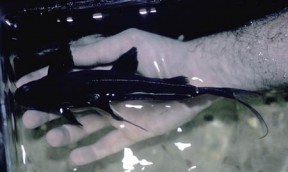Bagrichthys macracanthus
Black Lancer
Classification
Order: Siluriformes Family: Bagridae
Distribution
The type specimens were collected from the confluence of the Lamatang and Enim rivers, Palambang Province, Sumatra, Indonesia and the species may be endemic to Sumatra though it is traditionally considered to range into Borneo, Java and Indochina.
The fish found in the Chao Phraya and Mekong river basins in Thailand was described as B. majusuculus in 2002 while we’ve been unable to obtain definitive records from any of the Sunda Islands with the exception of Sumatra.
Habitat
Typically inhabits large, turbid rivers with muddy substrates and slow flow and moves moves into flooded riparian zones to spawn during the wet season.
Maximum Standard Length
200 – 230 mm.
Aquarium SizeTop ↑
A tank with base measurements of 120 ∗ 45 cm ? should be the smallest considered.
Maintenance
A shy, nocturnal species so best maintained in a dimly-lit aquarium. Provide plenty of hiding places in the form of clay flowerpots, lengths of plastic piping, driftwood tangles etc.. Plants are not essential but useful in reducing the amount of light hitting the bottom of the tank as well as offering cover.
If you’re keeping multiple specimens or other similarly-sized catfishes try to arrange the décor in such a way as to form distinct territories.
The heater should also be placed in such a way that it doesn’t allow the fish to rest behind or against it. Also note that this species doesn’t appreciate strong water flow.
Water Conditions
Temperature: 24 – 28 °C
pH: 5.5 – 7.0
Hardness: 18 – 268 ppm
Diet
Apparently feeds on small, benthic animals and organic detritus in nature but will accept most aquarium foods.
Small live and frozen fare such as Artemia, Tubifex, bloodworm, etc., are particularly suitable, and high-quality, sinking dried products enriched with Spirulina or other vegetable content should also be offered regularly.
Behaviour and CompatibilityTop ↑
Peaceful with species inhabiting other areas of the tank and has a relatively small mouth so is unable to swallow anything larger than a few millimetres in length.
It may be seen more often if maintained alongside schools of ‘dither’ fishes, for which good choices include larger rasboras, medium-sized barbs or perhaps the glass catfish Kryptopterus minor.
It is territorial towards other benthic species, especially conspecifics, and males in particular will not often tolerate each other in all but the largest aquaria. Keep a single male alongside 3 or more females for the best chance of long-term success as this should help reduce the chance of any single individual being targeted by the dominant male.
Sexual Dimorphism
Males possess a pointed, externally visible genital papilla located just anterior to the anal fin and noticeably longer barbels, while sexually mature females are normally slightly larger-bodied.
Reproduction
Unrecorded in captivity as far as we know. In nature adults move into temporarily-flooded areas at the onset of the wet season to spawn.
NotesTop ↑
The vernacular name ‘lancer’ is derived from the extended dorsal spine possessed by several members of the genus, which currently contains 7 species.
Among them B. macracanthus is most similar to B. majusculus and B. vaillantii but can be told apart from the former by possession of shorter pectoral spines (13.3 – 16.2 % SL vs. 15.8 – 20.7 %), shorter adipose fin (38.8 – 45.8 % SL vs. 46.0 – 50.7 %), less deep caudal peduncle (5.6 – 7.0 % SL vs. 7.1 – 7.5 %) and larger adult size. From B. vaillantii it differs in possessing a gently sloping dorsal profile (vs. steeply-sloped), longer dorsal-fin spine (24.4 – 32.9 % Sl vs. 18.2 – 21.9 %) and larger adult size.
References
- Linder, R. S. and H. H. Ng, 2002 - Cat Chat: The Official Journal of The Catfish Study Group 3(3)
Notes on the Lancers of the Genus Bagrichthys (Teleostei, Bagridae) - Ng, H. H. , 2002 - Folia Zoologica 51(1): 49-54
Bagrichthys majusculus, a new catfish from Indochina (Teleostei, Bagridae).






